Recently, the discovery of a new mutation type has challenged the long-standing theory that cancer results from DNA rearrangements and mutations. The rising popularity of genomic sequencing has allowed for the visualization of a new type of mutation known as chromothripsis. This mutation type is characterized by chromosomal rearrangements in one or a few chromosomes following a singular catastrophic event in a cell’s history that causes mutagenesis, commonly leading to cancer and congenital diseases because these affected cells continue to divide.
The mechanism by which chromothripsis occurs is currently unknown, although the involvement of micronuclei has been proposed. Micronuclei are essentially small nuclei that form when chromosomes or chromosomal fragments are not incorporated into a dividing cell’s daughter nuclei following mitosis. The formation of these micronuclei has been associated with genomic damage, particularly in the improperly segregated chromosomes or chromosomal segments. After mitosis, these micronuclei can combine with the daughter nuclei, thus integrating mutations into the genomic DNA.
Image Source: Ed Reschke
Researchers recently performed live cell imaging and genomic analyses of individual cells to show that the formation of these micronuclei can generate many types of complex chromosomal rearrangements, providing concrete and direct experimental evidence for the mechanism of chromothripsis. Using live-cell imaging, scientists visualized cells with a ruptured micronuclear envelope during the S phase of interphase, when the cell is undergoing DNA replication. Using live imaging, cells with no detectable micronuclei were selected after a single cell division. Because these cells had micronuclei that disappeared following the first singular cell division, these cells were presumed to have damaged chromosomal material from the micronuclei incorporated into the genome.
Because decreased DNA replication is associated with the presence of micronuclei, the two daughter cells can have odd numbers of chromosomes and have different chromosomal copy numbers from each other. Researchers identified the mis-segregated chromosomes by examining DNA copy number, the number of copies of a given fragment of DNA. The cells containing mis-segregated chromosomes were sequenced, and these cells were shown to have a significant increase in chromosomal rearrangements. This increase is not seen in properly segregated chromosomes.
These experiments showcase the importance of maintaining nuclear integrity within cells. These findings will hopefully inspire new treatments for cancer and congenital diseases.
Feature Image Source: microarray by Kat Masback










